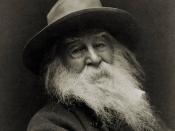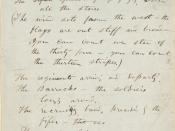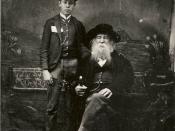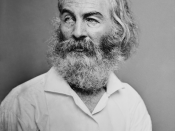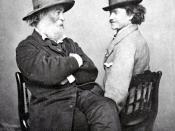The poems Beat! Beat! Drums! and The Colonel use imagery to broadcast their message. While Whitman uses more subtle imagery utilizing strong words and sound, partly through closed form, to exaggerate his point, Carolyn ForchÃÂé uses graphic, detailed imagery and open form to reveal her claim. Each poem's purpose is nothing short of forcing the reader to reach an opinion on war. Whitman and ForchÃÂé have opposite views on how to accomplish this task, unfortunately for Whitman, ForchÃÂé's ideas work are far superior.
Each of these poems is similar in the respect that they focus on war. While they reach different conclusions, they both present some of the same points. Some of these points being the harshness of war, the separation among people that war leads to, as well as the idea that everyone is involved to some extent. The authors also use imagery as their engine showing the similarity of construction in both poems.
In Beat! Beat! Drums! Walt Whitman's uses closed form, trochaic meter, and many forced pauses to control the reader's focus. His form, while trying to simulate the strong organization and structure of the military, forces the reader to create a new picture or scene for every single description. It is impossible to meld his scenes into one bigger scene, because his words, "Into the solemn church, and scatter the congregation, / Into the school where, scholar is studying;"ÃÂ simply do not allow it. Whitman's use of pauses, in effect stopping to wash the canvas, deny any hope of creating one big painting. However, the form does allow Whitman to emphasize certain phrases and words ensuring that every reader paints a similar picture, his picture. He stops so often, introducing a certain amount of chaos and limiting flow. While his pauses disrupt the imagery, they also add to the image of the military marching or lining up for battle. While the military is though to be strict and well organized, there is no war without chaos. Whitman's point; War is chaos and chaos is war.
The specific words used, and the order in which they are placed, cause Whitman to be viewed as a narrator, "Over the traffic of cities-over the rumble of wheels in the streets."ÃÂ One reads these words and immediately feels removed, as if being told the story and having the narrator's view forced upon you, instead of experiencing it firsthand. Whitman's strong words and phrases, such as "ruthless force, shrill, so fierce you whirr, and shake the dead where they lie,"ÃÂ furthermore employ the notion that a story is being told. Stories are very different from firsthand experience; they must use strong words and frequent pauses to boost the senses and capture the true emotion of the event. Emotion is key to telling a story so if a storyteller can effectively transfer the emotion of his story and allow for a single vivid image, the essence or moral will remain in the minds of anyone. While Beat! Beat! Drums! is effective in telling the story, its strong words over power the images and deny the creation of one single picture in the mind, impeding the poem's ability to remain in the mind of the reader.
ForchÃÂé uses open form design, in The Colonel, to engulf the reader in a prose-like trance. This allows the reader to pause at his own will and take notice of what interests him, allowing emphasis to be placed wherever the reader wants. ForchÃÂé's style, while creating an image in the mind, casts the reader into the image of the poem. As the reader is now a part of the poem, images appear clearer and much more vivid. The Colonel, unlike Whitman's poem, uses simple words with simple meanings to paint its picture. These words allow for small pieces of the painting to form with more time to create detail. The pieces come together slowly, "I was in his house"æ His daughter filed her nails, his son went out for the night"ædaily paper, pet dogs, and a pistol on the cushion beside him."àBuilding on each piece, ForchÃÂé actually causes the reader to believe he is in the poem, looking around and experiencing the poem firsthand.
Now that ForchÃÂé has a strong hold on the reader's emotions, she begins to take control and increase the tension, "The Colonel"æpushed himself away from the table. My friend said to me with his eyes: say nothing. The colonel returned with a sack used to bring groceries home. He spilled many human ears on the table"ætook one of them in his hands, shook it in our faces."àAs the tension rises, the words do not grow stronger, they remain as simple as in the beginning. If ForchÃÂé changed the style or strength of the words, the reader would have realized the loss of control and prematurely escaped the "world"àof the poem. However, the true graphic nature and vivid images portrayed in the poem create a feeling of uneasiness, which then causes the reader to withdraw from the poem's world and reflect in the real world. This is a brilliant attempt at foreshadowing life and the world in which life exists. It also focuses sends the reader into the last few lines of the poem with a heightened sense awareness and morality intensifying the final scene, "Something for your poetry, no? he said. Some of the ears on the floor caught the scrap in his voice. Some of the ears on the floor were pressed to the ground."àThis final scene, more exactly the two final sentences, asks a question without actually asking the question. Should we listen or not? Do we turn our military back or keep advancing in our struggles? ForchÃÂé's choice of open form and simple, concise words, engulfing the reader and hurling him into it, force the reader to recognize the question while creating a desire to answer it.
Though each poem talks of war and has a few similar characteristics, the poems are drastically different. In fact, they are the two extremes of poetic imagery. Whitman's closed form, with strong words and forced pauses, imposes his view of war, a view of acceptance and anticipation, on the reader, while ForchÃÂé requires the reader to arrive at his own view. While Beat! Beat! Drums! leaves the reader arguing for or against Whitman's point of view, The Colonel leaves the reader to decide his point of view and eventually support it while arguing why it is correct. This internal battle and desire to be correct causes The Colonel to imprint in the mind of the reader, never to be forgotten.
